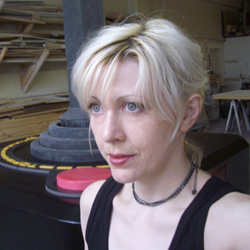
Mary Flanagan has spent her career thinking critically about a topic that most of us take for granted: play. A professor of digital humanities at Dartmouth College, Flanagan also directs the Tiltfactor Lab, a game research group that she founded in 2003 and that works to design and investigate games for social change. Here, she talks about archives, vaccination, and failure as a path to success.
Let’s talk about Metadata Games, your new suite of online games that invite players to tag images from the archives of the Dartmouth library.
It’s taking on the challenge to help digitize more cultural material—I’m worried about losing access to, and knowledge about, those artifacts that aren’t digitized—losing the history of things. We’re forgetting in the culture those things not found online. Some archival photographs have little or no stored context with them. Metadatagames helps to fill in the gaps, providing clues to each artifact.
What inspired you to build it?
Metadata Games was originally inspired by Luis von Ahn at Carnegie Mellon, who does a lot of interesting crowdsourced applications. Unfortunately, his stuff is not really accessible on a free and open-source software model. At Tiltfactor, we wanted to build a system that anybody could use — the Smithsonian, the Library of Congress, the archive of a small non-profit — without having to resort to putting material on Google.
Has it been adopted by other institutions?
We’ve had 10 or 15 downloads so far, but we’re still testing it. We’ve kept downloads by request only because we don’t have the resources to support it as much as we want to, though that’s coming.
When you start thinking about a new project, do you begin with an idea or with a structure or mechanic of play?
It depends on the project. Sometimes people come to us at Tiltfactor and say, "We need help with something," and it becomes an interesting conceptual issue. We don’t do work for hire, but we do take on projects that we think can make an educational impact. Take POX, for example. We wanted to do a game for health, and we had a discussion about vaccination with a local nonprofit in New Hampshire. They were saying that nobody knows how to increase vaccination, because people are either on one side of the fence or the other. So we started thinking about what was the best way for people to have a conversation about immunization. Is it a matter of scientific literacy or is it opinion changing?
This is the board game you released earlier this year that helps players understand group immunity by challenging them to stop the spread of a deadly disease.
We thought a board game would be a good way to foster a discussion. But we’re media agnostic. I see games as technologies, no matter what format they are, and whether they are analog or digital. We’re also doing an iPad version of POX, and it’s really interesting to see how the conversation changes around a digital artifact.
What have you learned about good game design over the years?
Wow, let’s see. In no particular order, I would say that there has to be some kind of challenge set up. Classically, one thing that’s been typical of good game design is appropriating risk of some kind. But I think that might be an older model. You don’t really face a lot of risk in casual games these days, like the games played on the iPhone—take Pocket Frogs, for example. In fact, you receive a lot of reward with very little if any risk. Is such design a reflection of players’ attention span, patience, hopes, or fears?
Games also offer the opportunity for failure. And when you think about games in an educational context, certainly trial and error and failure and restarting — those are not necessarily the primary methods by which people are taught. They happen in other things, like sports and music practice. But in higher education, embracing failure as a path to success? That would be interesting to explore.
What else are you working on these days?
I’m writing a manuscript on concepts of borders, inspired by a series of border walks I was doing in virtual worlds earlier in the year. I’d go into virtual worlds and particularly into historical recreations — so, for example, you’re in Second Life and you’re in Eleanor of Aquitaine’s castle — and walk around. I was interested in ideas of recreation and virtuality but also the seams at which some of our virtual worlds expose themselves as different from the real thing, and what they imply.
Leah Hoffmann is a technology writer based in Brooklyn, NY.



Join the Discussion (0)
Become a Member or Sign In to Post a Comment